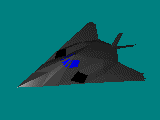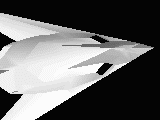


F-117A Nighthawk
 The F-117A Nighthawk is the
world's first operational aircraft designed to exploit low-observable
stealth technology. The unique design of the single-seat F-117A
provides exceptional combat capabilities. About the size of an F-15
Eagle, the twin-engine aircraft is powered by two General Electric
F404 turbofan engines and has quadruple redundant fly-by-wire flight
controls. Air refuelable, it supports worldwide commitments and adds
to the deterrent strength of the U.S. military forces.
The F-117A Nighthawk is the
world's first operational aircraft designed to exploit low-observable
stealth technology. The unique design of the single-seat F-117A
provides exceptional combat capabilities. About the size of an F-15
Eagle, the twin-engine aircraft is powered by two General Electric
F404 turbofan engines and has quadruple redundant fly-by-wire flight
controls. Air refuelable, it supports worldwide commitments and adds
to the deterrent strength of the U.S. military forces.
The F-117A can employ a variety of weapons and is equipped with
sophisticated navigation and attack systems integrated into a
state-of-the-art digital avionics suite that increases mission
effectiveness and reduces pilot workload. Detailed planning for
missions into highly defended target areas is accomplished by an
automated mission planning system developed, specifically, to take
advantage of the unique capabilities of the F-117A.
Streamlined management by Aeronautical Systems Center,
Wright-Patterson AFB, Ohio, combined breakthrough stealth technology
with concurrent development and production to rapidly field the
aircraft. The F-117A program has demonstrated that a stealth aircraft
can be designed for reliability and maintainability. The aircraft
maintenance statistics are comparable to other tactical fighters of
similar complexity. Logistically supported by Sacramento Air Logistics
Center, McClellan AFB, Calif., the F-117A is kept at the forefront of
technology through a planned weapon system improvement program located
at USAF Plant 42 at Palmdale, Calif. The Air Force thinking today is
that it will phase out the Nighthawks after 2018.
The first F-117A was delivered in 1982, and the last delivery was
in the summer of 1990. The F-117A production decision was made in 1978
with a contract awarded to Lockheed Advanced Development Projects, the
"Skunk Works," in Burbank, Calif. The first flight was in 1981, only
31 months after the full-scale development decision. Lockheed-Martin
delivered 59 stealth fighters to the Air Force between August 1982 and
July 1990. Five additional test aircraft belong to the company.
Air Combat Command's only F-117A unit, the 4450th Tactical Group,
achieved operational capability in October 1983. Since the F-117’s
first Air Force flight in 1982, the aircraft has flown under different
unit designations, including the 4450th Tactical Group and the 37th
Tactical Fighter Wing at Tonapah Test Range, NV; the 57th Fighter
Weapons Wing, Nellis AFB, NV; the 410th Flight Test Squadron/410th
Test Squadron, Palmdale, CA; and Detachment 1, Test Evaluation Group,
also at Holloman, which falls under the 53rd Wing, Eglin AFB, FL.
The stealth fighter emerged from the classified world while
stationed at Tonapah Airfield with an announcement by the Pentagon in
November 1988 and was first shown publicly at Nellis in April
1990. The 4450th TG was deactivated in October 1989, and was
reactivated as the 37th Tactical Fighter Wing.
In 1992 the F-117A Nighthawk made its new home at Holloman Air
Force Base. The official arrival ceremony for the F-117 to Holloman
AFB was conducted 09 May 1992. The 49th Fighter Wing (49FW) at
Holloman serves as the only F-117 Home Station. The 49th Operations
Group operates and maintains the F-117A aircraft. The 7th CTS
"Screamin' Demons" serves as the transition training unit, preparing
experienced Air Force pilots for assignment to the F-117A
Nighthawk. The 8th and 9th Fighter Squadrons are designated to employ
the F-117A Nighthawk in combat. Once an F-117 pilot has successfully
completed training, he is then assigned to one of only two operational
Nighthawk squadrons--the 8th FS "Black Sheep" and the 9th FS "Flying
Knights." The 49FW provides full compliment of flightline maintenance
capabilities as well as back-shop support. The F-117 deploys in
support of contingency operations, as directed by National Command
Authorities. Flightline maintenance support is deployed concurrent
with the aircraft. Depending on the deployment duration, varying
levels of back shop maintenance support may also be deployed.
The F-117A first saw action in December 1989 during Operation Just
Cause in Panama. Two F-117A fighters targeted the field outside the
Panamanian Defense Forces barracks at Rio Hato with BLU-109 2,000
lb. bombs to stun and disorient the troops quartered in those barracks
in preparation for an assualt by US Army Rangers. Technical failures
and communications mixups caused the pilots to miss their targets,
dropping the bombs farther away from the barracks than intended.
The stealth fighter attacked the most heavily fortified targets
during Desert Storm (January-February 1991) , and it was the only
coalition jet allowed to strike targets inside Baghdad's city
limits. The F-117A, which normally packs a payload of two 2,000-pound
GBU-27 laser-guided bombs, destroyed and crippled Iraqi electrical
power stations, military headquarters, communications sites, air
defense operation centers, airfields, ammo bunkers, and chemical,
biological and nuclear weapons plants.
Although only 36 stealth fighters were deployed in Desert Storm and
accounted for 2.5 percent of the total force of 1,900 fighters and
bombers, they flew more than a third of the bombing runs on the first
day of the war. In all during Desert Storm, the stealth fighter
conducted more than 1,250 sorties, dropped more than 2,000 tons of
bombs, and flew more than 6,900 hours. More than 3,000 antiaircraft
guns and 60 surface-to-air missile batteries protected the city, but
despite this seemingly impenetrable shield, the Nighthawks owned the
skies over the city and, for that matter, the country. The stealth
fighter, which is coated with a secret, radar-absorbent material,
operated over Iraq and Kuwait with impunity, and was unscathed by
enemy guns.
F-117 fighters deployed to the Gulf several times during the late
1990's to support U.S. attacks against Iraq designed to deprive Saddam
Hussein of his Weapons of Mass Destruction (WMD) programs and to force
his compliance with the UN monitoring regime. F-117 fighters deployed
to the Gulf during Operation Desert Fox to upgrade the strike force's
capability to attack high-value targets. But the 18 hour flight from
the F-117s' home base to Kuwait meant that the operation was over
before the F-117 aircraft arrived in the Gulf.
On 22 January 1997 Lockheed Martin delivered the first F-117A with
the "RNIP-Plus"-navigation system from Honeywell after it had been
overhauled in Palmdale (California). The F-117A now operates with
laser gyroscopes and a GPS receiver, giving the aircraft a much higher
precision than the inertia platforms did, which were previously used
and which could show deviations of several hundred meters during a
flight. Apart from this, the old system was more expensive to
maintain.
In the opening phase of Allied Force, aimed primarily at
Yugoslavia's integrated air defense system, NATO air forces conducted
more than 400 sorties. During the first two night attacks, allied
troops in the air and at sea struck 90 targets throughout Yugoslavia
and in Kosovo. F-117 Nighthawks from the 8th Expeditionary Fighter
Squadron at Holloman Air Force Base NM participated in air strikes
against targets in the Balkans during NATO operations. One F-117
fighter was lost over Yugoslavia on 27 March 1999. A US search and
rescue team picked up the pilot several hours after the F-117 went
down outside Belgrade. Serbian air defenses managed to string
together a series of brief sightings, perhaps starting as early as the
F-117's takeoff in Italy, to project the F-117's course and loft an
anti-aircraft missile at the F-117 when it was most vulnerable. On 01
April 1999, Defense Secretary William Cohen directed 12 more F-117
stealth fighters to join NATO Operation Allied Force, to join the
total of 24 F-117s that were participating in NATO Operation Allied
Force.
In December 2001, TRW and Lockheed Martin Aeronautical Company
completed a series of success F-117 flight tests evaluating the
ability for commerical off the shelf (COTS) technology combined with
COTS emulation technology to execute the existing F-117 Operational
Flight Plan (OFP). TRW's Reconfigurable Processor for Legacy
Applications Code Execution (RePLACE) emulates legacy hardware on more
modern hardware, allowing that modern hardware to run legacy
applications without changes. This technology offers the potential
for low-cost, low-risk, incremental upgrades to aircraft processing
power. In the F-117 demonstrations, the technology performed
flawlessly, requiring no updates, generating no anomalies, and
surprising the evaluators.
The FY2003 budget continues to fund the Single Configuration Fleet
(SCF) effort to develop a single, optimized low observable
configuration for the F-117 fleet. Previously, the F117A fleet had
two major radar absorbing material (RAM) coating configurations,
costly and labor intensive panel access technology, and five leading
edge configurations. The configuration developed for SCF features new
leading edge technologies, spray-on coatings, new sheet RAMs, and new
panel access technologies. Standardizing the configuration will
preserve radar cross-section performance, reduce maintenance
requirements, and eliminate the separate procedures each aircraft
required previously. The SCF development contract was awarded June
1996, and all development and flight testing completed March 1999.
Conversion began late 1999, with first deliver early 2000. Conversion
will run through FY 2006.
In an effort to improve the combat effectiveness of the stealth
fighter, test experts from the F-117 Combined Test Force at Air Force
Plant 42 in Palmdale, Calif., are working to expand what it brings to
the fight. On April 2 2002, developmental test experts in Palmdale
teamed up with their operational counterparts from Holloman Air Force
Base, N.M., to complete the second phase of a demonstration project
designed to provide the F-117 and its pilots with the ability to
receive and transmit mission and target data in real-time from the
air. Phase one tests, completed in October of 1998, allowed a pilot to
receive live-threat information and manually replan a mission from the
cockpit. The second phase completed the test cycle by demonstrating
the transmission of real-time mission and target data out of the
cockpit and into the hands of command and control forces on the
ground.
Until this testing, the potential time-critical combat capabilities of
the F-117 had not been explored. The target data technology works by
allowing the aircraft to receive and transmit tactical information on
targets or pop-up threats via satellite communication. The fighter's
ability to send and receive text and images enhances its combat
flexibility yet does not compromise its stealth configuration.
Specifications
|
| Primary Function | Fighter/attack
|
| Contractor | Lockheed Aeronautical Systems Co.
|
| Power Plant | Two General Electric F404 engines
|
| Length | 65 feet, 11 inches (20.3 meters)
|
| Height | 12 feet, 5 inches (3.8 meters)
|
| Weight | 52,500 pounds (23,625 kilograms)
|
| Wingspan | 43 feet, 4 inches (13.3 meters)
|
| Speed | High subsonic
|
| Range | Unlimited with air refueling
|
| Armament | Internal weapons carriage Two each of:
2 MK84 2000-pound
2 GBU-10 Paveway II
2 GBU-12 Paveway II
2 GBU-27 Paveway III
2 BLU 109
2 WCMD
2 Mark 61
|
Unit Cost $FY98
[Total Program] | $122 million
|
| Crew | One
|
| Date Deployed | 1982
|
Inventory
As of Sept. 30, 2001
|
|
F-117 |
YF-117 |
|
PAI |
TAI |
PAI |
TAI |
| Active Duty |
44 |
52 |
3 |
3 |
| Air National Guard |
0 |
0 |
0 |
0 |
| Air Force Reserve |
0 |
0 |
0 |
0 |
| Totals |
44 |
52 |
3 |
3 |
|
PMAI
Primary Mission Aircraft Inventory Only combat-coded aircraft and not development/ test, attrition reserve, depot maintenance, or training aircraft. | 36 aircraft
|
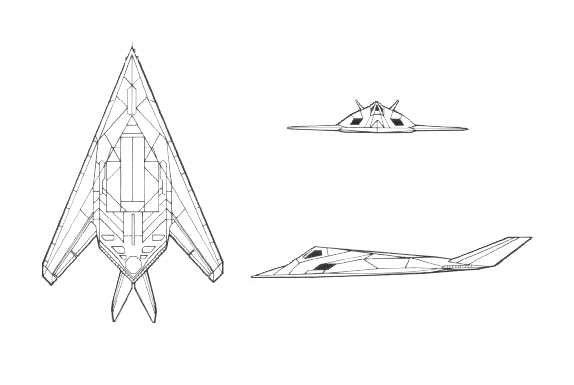
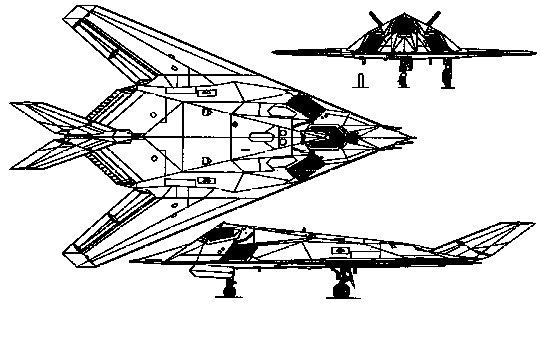
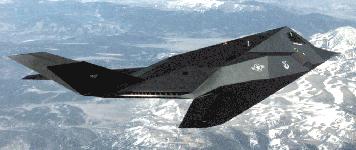
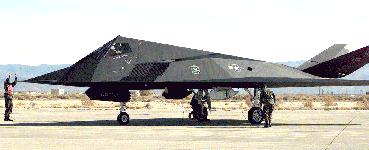
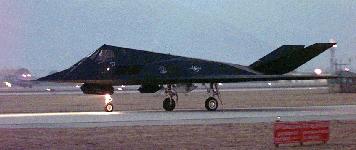
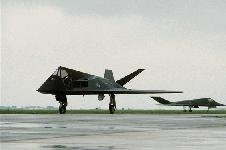
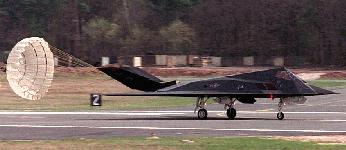
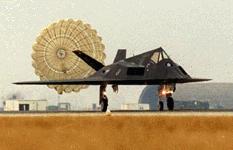
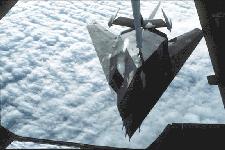
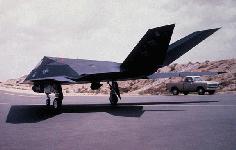
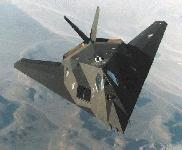
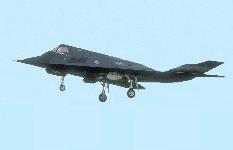
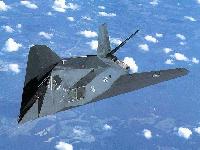
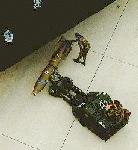
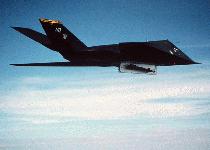
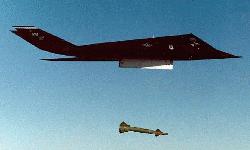
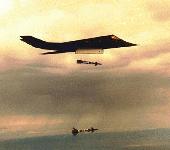
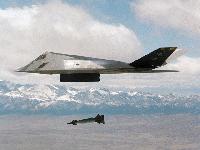
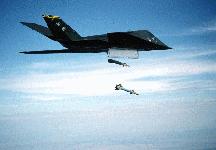
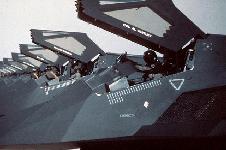
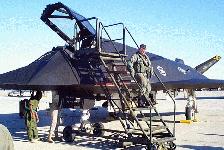
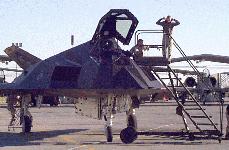
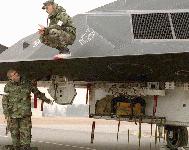
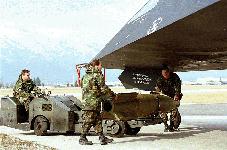
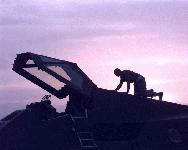
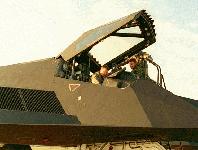
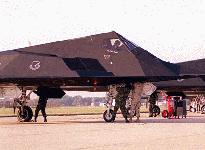
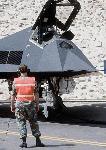
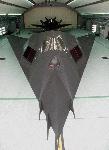
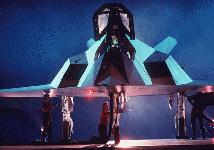
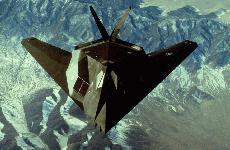
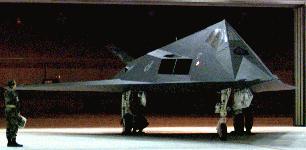
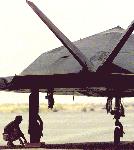
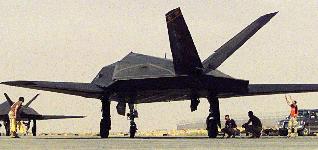
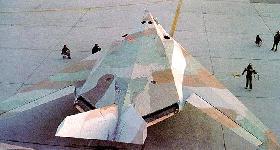
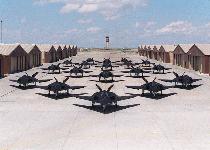
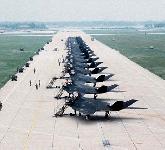
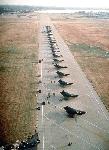
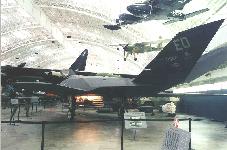
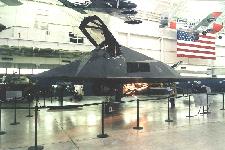
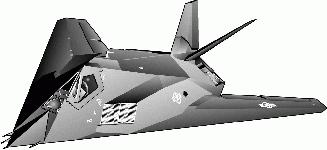
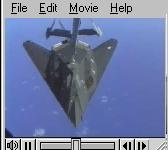
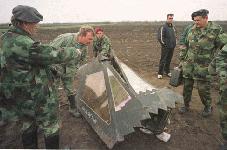
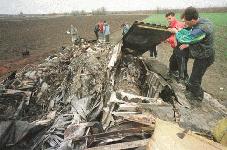
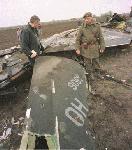
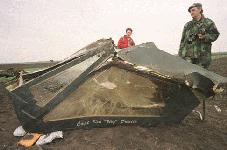
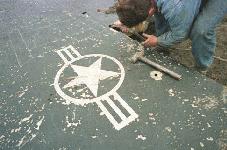
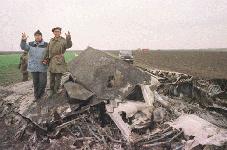
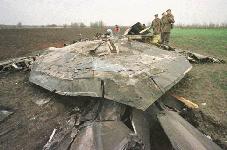
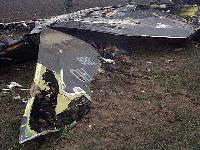
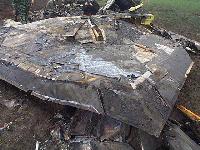
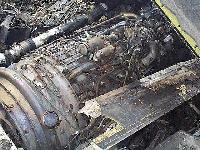
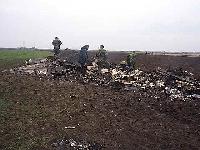
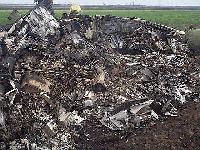
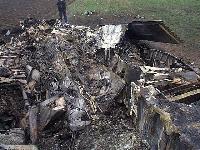
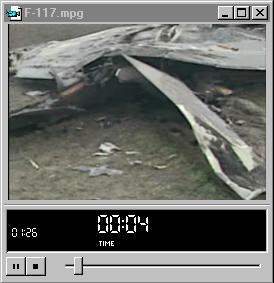
F-117 downed over Serbia
3551kb MPEG 90 seconds
Sources and Resources
- F-117 @ Elevon
- Lockheed Martin Skunkworks
- F-117A Nighthawk @ Holloman AFB
- F-117 @ CyberBob's Low Observables Page
- Stealth Secrets of the F-117 Nighthawk By Don Hollway
- F-117 @ [unofficial] Aircraft Defense Information Center
- PILOT OPERATIONAL PROCEDURES—F-117A - AIR COMBAT COMMAND INSTRUCTION 11-F117A
VOLUME 3 - 3 MARCH 1995 -- [122kb PDF] This instruction, with its complementary Chapter 8, Local Operating Procedures, prescribes standard operational and weapons employment procedures to be used by ACC pilots when operating USAF F-117A aircraft.
- ANNEX F Common Solution/Concept List (U) Air Force Mission Area Plan (MAP) [as of 11 July 1997 - Rev 10] - Detailed and comprehensive Air Combat Command descriptions of weapon system modernization efforts required to satisfy known needs.
- F-117A Squadrons FY98 R&D Budget Request
- Placing Steel On Target Airman Magazine October 1996 --Overview of Nighthawk and stealth fight performance the Persian Gulf War.
- F-117A crashes near Baltimore
Sept. 15, 1997 - An Air Force F-117A Nighthawk crashed Sept. 14, at 3 p.m. (EST) while performing a fly-by demonstration for an airshow at Martin State Airport, 12 miles northeast of Baltimore.
- Stealth fighters resume flying operations
Oct 8, 1997 (AFNS) -- The Air Force resumed F-117 Nighthawk stealth fighter flying operations Oct. 2 after initiating a fleetwide safety inspection. The commander of Air Combat Command had directed a precautionary fleet stand down following the F-117 mishap at the Chesapeake Air Show, Maryland, Sept 14. Physical evidence found in the crash debris revealed a significant defect in a support structure in the left wing of the accident aircraft.
- F-117 accident investigation report released
Dec 15, 1997 (AFNS) -- Air Combat Command released the accident investigation report Dec. 12 on the F-117A stealth fighter from Holloman Air Force Base, N.M., that crashed Sept. 14 near Baltimore, Md.
- F-117 stealth fighter logs 150,000 hours USIA 28 Aug 1998
- F-117 testers evaluate real-time information capability -- 04 August 1998 (AFNS) - IRRCA, or the Integrated Real-time Information into the Cockpit/Real-time Information Out of the Cockpit for Combat Aircraft flight test project, will greatly enhance the F-117's flexibility in combat.
- Downing
a Stealth Jet: Shrewd Tactics or a Lucky Shot? By ERIC SCHMITT
The New York Times April 11, 1999 -- A secret Air Force inquiry
believes a combination of tactics, quick learning and luck came
together in one brilliant moment. Serbian spotters in Serbia, and
perhaps in Bosnia and along the Montenegrin coast, may have patched
together enough quick glimpses of the warplane from scattered radars
to track the elusive aircraft, however briefly, to fire an SA-3
missile from a battery near Belgrade.
http://www.fas.org/man/dod-101/sys/ac/f-117.htm
Maintained by Robert Sherman
Originally created by John Pike
Last updated
 The F-117A Nighthawk is the
world's first operational aircraft designed to exploit low-observable
stealth technology. The unique design of the single-seat F-117A
provides exceptional combat capabilities. About the size of an F-15
Eagle, the twin-engine aircraft is powered by two General Electric
F404 turbofan engines and has quadruple redundant fly-by-wire flight
controls. Air refuelable, it supports worldwide commitments and adds
to the deterrent strength of the U.S. military forces.
The F-117A Nighthawk is the
world's first operational aircraft designed to exploit low-observable
stealth technology. The unique design of the single-seat F-117A
provides exceptional combat capabilities. About the size of an F-15
Eagle, the twin-engine aircraft is powered by two General Electric
F404 turbofan engines and has quadruple redundant fly-by-wire flight
controls. Air refuelable, it supports worldwide commitments and adds
to the deterrent strength of the U.S. military forces.


